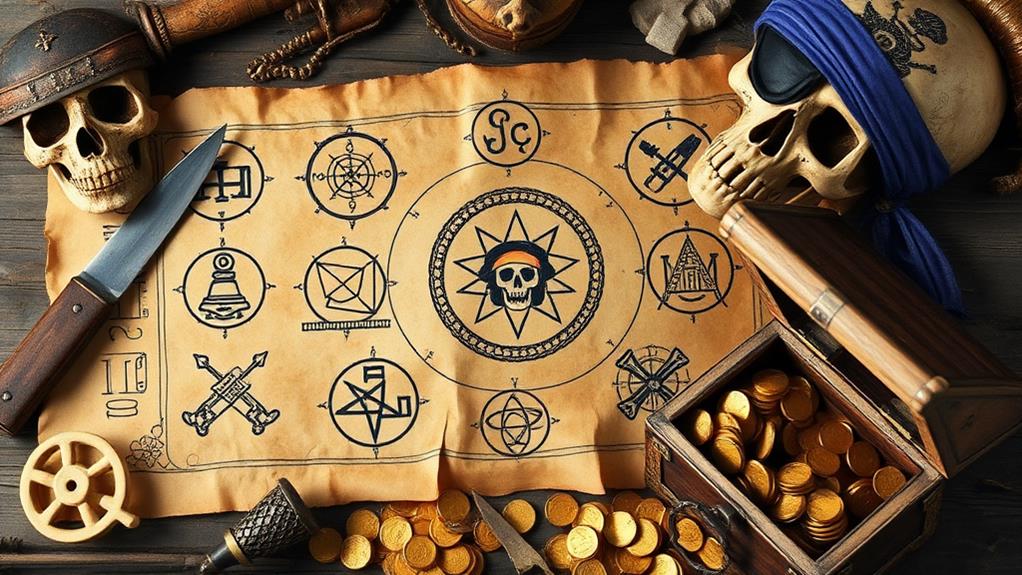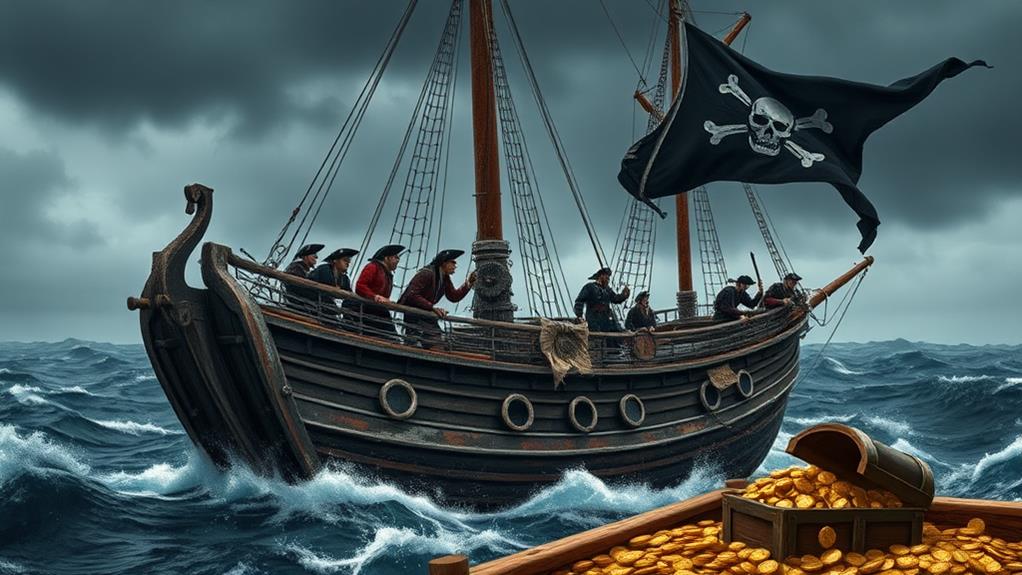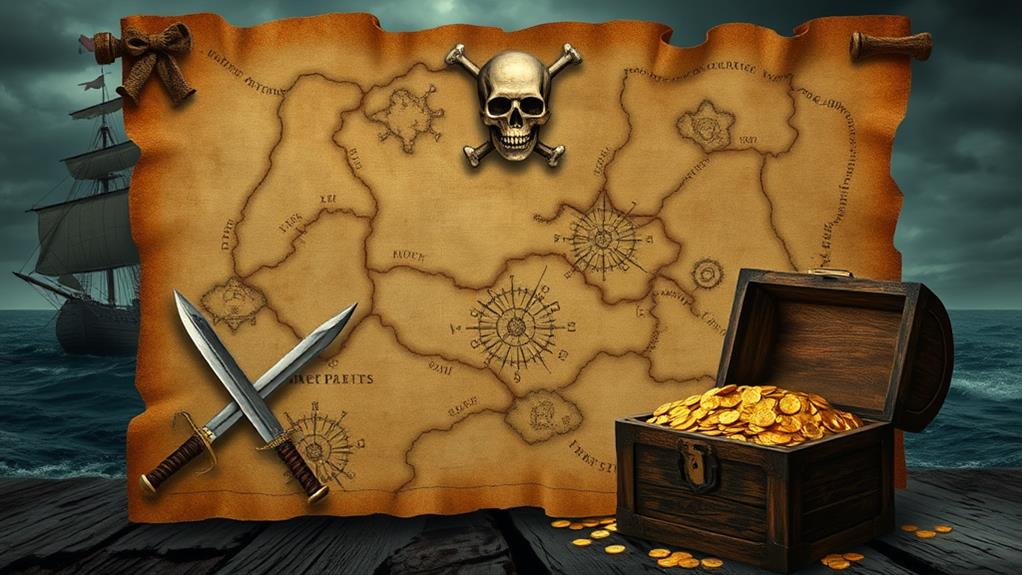
You've likely heard tales of infamous pirates, but few know about the strict codes and laws that governed their lives. Bartholomew Roberts' code prohibited gambling and set compensation for injuries, while Henry Morgan's articles emphasized discipline and fairness in plunder division. The Code of the Black Flag guaranteed every pirate had a voice, maintaining unity and equity. Edward Low's articles demanded strict obedience with brutal punishments for disobedience. The Pirate Code of the Brethren offered a democratic approach, fair loot distribution, and compensated injuries. Discover how these codes fostered order, loyalty, and survival among pirate crews.
The Pirate Code of Bartholomew Roberts

Exploring historical pirate codes reveals the fascinating and surprisingly structured world of pirate life, and there's no better place to start than with the Pirate Code of Bartholomew Roberts. Known as "Black Bart," Roberts was one of the most successful pirates of the Golden Age, and his code was a strict set of rules that governed his crew's behavior.
Roberts' code included regulations on everything from gambling to lights-out hours. For instance, Article VI prohibited gambling on board, ensuring that disputes over money didn't disrupt the crew's unity. Article VIII mandated that lights had to be out by 8 p.m., with exceptions only for those who needed to stay awake for their watch.
One of the standout articles was Article IX, which outlined compensation for injuries. If you lost an arm or leg, you were entitled to 800 pieces of eight or its equivalent, ensuring that crew members felt secure despite the inherent dangers of piracy.
Discipline was also vital. Article XII stated that if any man deserted the ship or his quarters in battle, he would receive punishment by death or marooning. These rules helped maintain order and fairness, making Roberts' crew one of the most formidable on the high seas.
Henry Morgan's Articles
Henry Morgan's Articles provide another intriguing glimpse into the structured world of pirate governance. When you excavate Morgan's code, you'll find a well-organized set of rules that emphasize discipline and fairness among his crew. Unlike the chaotic image you might have of pirates, Morgan's articles secured order and mutual respect.
One key aspect was the division of plunder. Morgan's Articles clearly outlined how loot should be shared, guaranteeing everyone got a fair cut based on their role and contribution. This fairness fostered loyalty and minimized disputes. Another important rule was the compensation for injuries. If you lost a limb or sustained a serious injury during a raid, you'd receive a predetermined sum, showing a sense of care and responsibility within the crew.
Morgan also enforced strict rules on conduct. Any theft among the crew was harshly punished, maintaining trust and unity. Drunkenness during battle or neglect of duty could lead to severe penalties, guaranteeing everyone remained focused and reliable. Henry Morgan's Articles stand out as an attestation to the structured, almost democratic, way pirates governed themselves, far from the anarchy often depicted in popular culture.
The Code of the Black Flag

While Henry Morgan's Articles highlight a structured and disciplined pirate society, the Code of the Black Flag takes this organization to another level. Under this code, pirates adhered to a strict set of rules that guaranteed the crew operated efficiently and fairly. Every member had a voice in pivotal decisions, from choosing a captain to deciding the fate of prisoners. This democratization fostered a sense of unity and shared purpose among the crew.
The Code of the Black Flag also included detailed provisions for dividing plunder. Shares were allocated based on rank and contribution, certifying everyone received their fair due. Even injured pirates were compensated, with specific shares set aside for those who lost limbs or suffered other debilitating injuries. This attention to fairness helped maintain morale and loyalty among the crew.
Interestingly, the code enforced discipline through a system of punishments for transgressions. Theft from fellow pirates, for instance, was met with severe penalties, including marooning. By maintaining strict discipline and fairness, the Code of the Black Flag guaranteed that piracy, despite its outlaw nature, operated under a surprisingly sophisticated and equitable framework. This structure was vital for the survival and success of pirate crews on the high seas.
Edward Low's Articles of Agreement
Edward Low's Articles of Agreement showcased the brutal and ruthless nature of his leadership. As a pirate captain, Low demanded strict obedience and meted out harsh punishments to those who defied him. You'd find that his code wasn't just about maintaining order; it was about instilling fear and ensuring loyalty through intimidation.
Low's articles included severe consequences for desertion or theft among the crew. If you were caught stealing, you'd likely face a gruesome death or marooning on a deserted island. Low believed that such draconian measures were necessary to keep his men in line and prevent mutiny.
One striking aspect of his Articles of Agreement was the emphasis on absolute equality in the division of plunder. Everyone, from the captain to the lowest deckhand, received an equal share, ensuring that loyalty wasn't just a matter of fear but also of fairness in rewards. However, if you were caught hiding any part of the loot, the punishment was severe—often resulting in death.
Additionally, Low demanded that any captured ships' officers and passengers be treated with extreme cruelty, often leading to their torture or execution. His code reflected his notorious reputation, making it clear that mercy had no place in his reign of terror.
The Pirate Code of the Brethren

Contrasting Edward Low's brutal Articles of Agreement, the Pirate Code of the Brethren offered a more structured and democratic approach to pirate life. You'd find that these codes, popularized by pirates like Bartholomew Roberts, aimed to create a sense of fairness and order among the crew. Everyone had a say in major decisions, and the captain's power was often balanced by a quartermaster, who represented the crew's interests.
One standout rule was the division of loot. The Pirate Code guaranteed that shares were distributed equitably. Captains and officers received larger shares, but every crew member got a portion, which fostered a strong sense of unity and motivation.
Another important aspect was the emphasis on discipline and order. For instance, disputes were settled through a duel onshore, under strict conditions to avoid unnecessary bloodshed. This helped maintain internal peace and cohesion.
Additionally, the Pirate Code outlawed cheating, gambling, and bringing women aboard without permission, reducing potential conflicts. Injured pirates were compensated, safeguarding loyalty and long-term commitment. By embedding fairness and collective decision-making, the Pirate Code of the Brethren provided a more humane and organized alternative to the cutthroat world of piracy.
At a Glance
You've traveled through the fascinating world of pirate codes and laws, each one a treasure map of its own. From Bartholomew Roberts' strict rules to the infamous Black Flag code, these pirate laws weren't just ink on parchment; they were the lifeblood of pirate society. Now, armed with this knowledge, you're ready to set sail on your own adventures. Remember, even pirates needed a code to navigate the stormy seas. So, what's your code?






